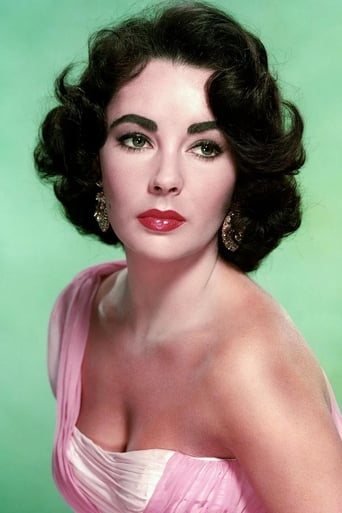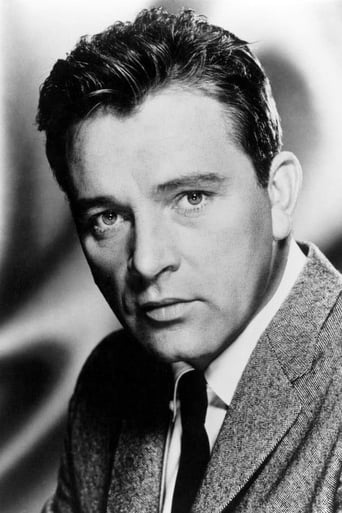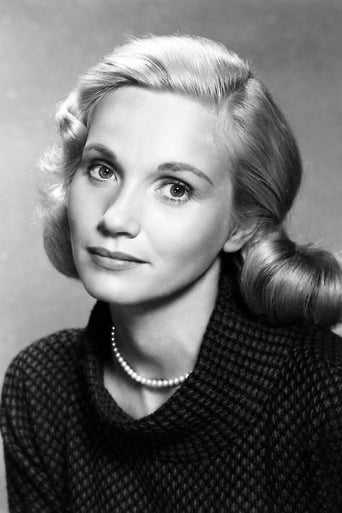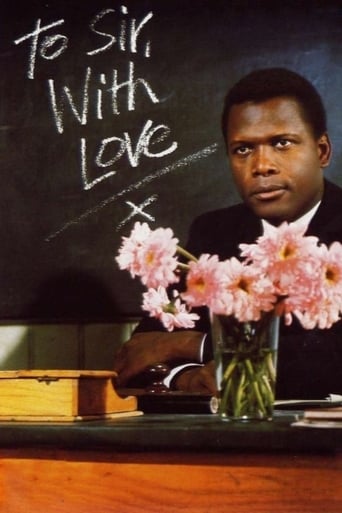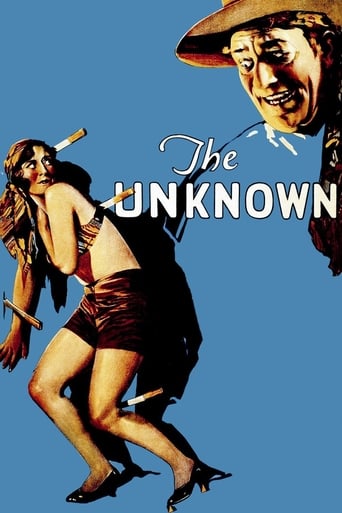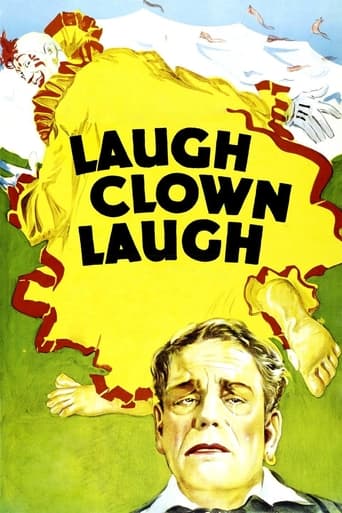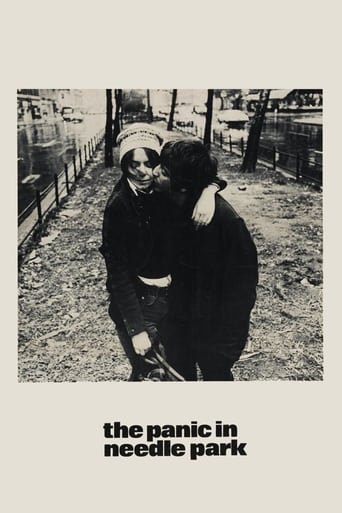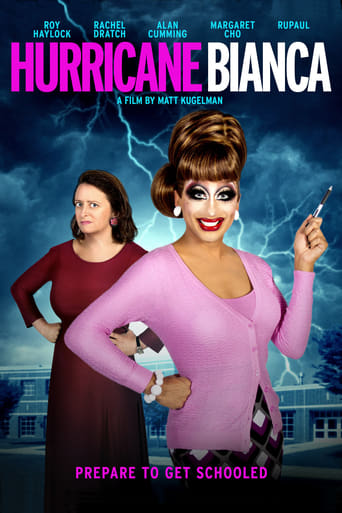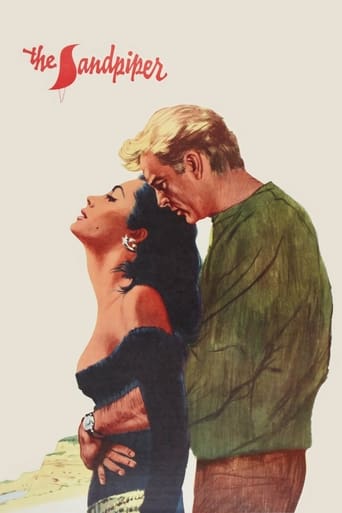

The Sandpiper (1965)
A free-spirited single mother forms a connection with the wedded headmaster of an Episcopalian boarding school in Monterey, California.
Watch Trailer
Cast
Similar titles
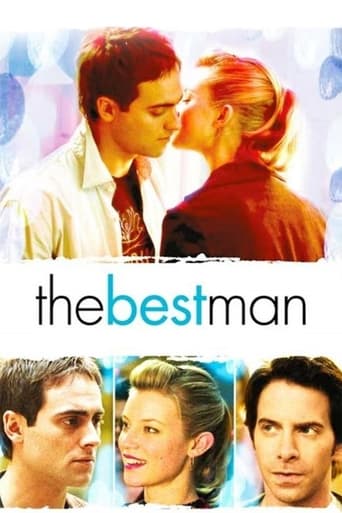
Reviews
I love this movie so much
Please don't spend money on this.
Highly Overrated But Still Good
Great example of an old-fashioned, pure-at-heart escapist event movie that doesn't pretend to be anything that it's not and has boat loads of fun being its own ludicrous self.
I just remembering watching this movie in 1984,in that time gave 6/10 now in first time on DVD it refresh my mind on this fine picture,if was directed by the great Vincente Minnelli is worth to see itself,Taylor and Burton make a convincing performance in their roles,she as unmarried free woman with a son and he as Dr.Reverend who is school director,they get attracted each other ended up a dead end,he realize that your work is just a keeper of treasure's God when he raised funds to Church in fraudulent way making bad fiscal agreements to take the money,the conflicts existential driven him to start again in a new place alone...strong matters nowadays...Resume: First watch: 1984 / How many: 2 / Source: TV-DVD / Rating: 7.5
One of director Vincente Minnelli's more interesting films, "The Sandpiper" stars Elizabeth Taylor as Laura Reynolds, a free-spirited mother who lives with her youngest son Danny. Laura – the film is very heavy-handed – is a full blown hippie. She's super liberated, is a single mom, atheist, home-schools her kid, lives on the beach, is a painter, promiscuous, hates social norms, her best friend is black and she hangs out with radicals. Oh, and she flaunts her boobs. Damn those beatniks.Mirrored to Laura is Dr Edward Hewitt (Richard Burton), the headmaster of an Episcopal boarding school. Edward is, of course, an ultra conservative. He's everything Laura isn't: rigid, a stickler for rules and regulations, an authoritarian, fundamentalist, traditionalist and stuck in a loveless marriage.Laura and Edward fall in love, but Laura's unconventionality and uninhibitedness disturbs Edward. He begins to have a crisis of faith. When the couple have sex one night, both fall apart. He questions the principles he's always held, she can't believe she's fallen for a man who represents everything she abhors. Realizing the hypocrisy of being a local authority figure who represents charity, religion and decency but takes bribes and bends to the whispers of women and money, Edward scuttles his job. He begins to spend more time with Laura. Maybe she can fix him. Big mistake. Edward's wife learns of the couple's liaisons and Edward is publicly shamed. He's pushed out of town. It's all very melodramatic.Look beyond the lust and you have one of Minnelli's more political films; a film about the political Left and Right recognising that, gee, maybe the Right should relax and the Left should appreciate a little discipline. The film's title refers to a bird which Laura heals and sets free. Laura teaches Edward as she heals this bird, the woman then releasing both into the wild. The film ends with Laura on a beach, Edward high above her on a hill. Symbolically the two positions they represent cannot meet or be reconciled. And so Edward stands on a rock, a mountain face epitomising his rigidity and spiritual arrogance. Laura sits below him, an outsider."The Sandpiper" oozes the era in which it was made. Only in this particular zeitgeist would you have a homosexual director making a politically charged beatnik flick which criticised catholic figureheads, was brazenly sexual, hinged on infidelity and featured Charles Bronson as a gypsy hippie. Minnelli's style is also wonderfully over the top. This is SUPER MELODRAMA, his direction deliberately operatic, campy, baroque and hyper stylised. It's the kind of film which uses crashing waves as a metaphor for sex and giant boobs as a symbol for all that is self-assured womanness. Everything's BIG BIG BIG. Voluptuous. Lurid. Modern audiences unaccustomed to this style have criticised Minnelli, but that was always part of his charm.Some of Minnelli's symbolism is subtle. Urban centres, houses and hard buildings are constantly clashed with more naturalistic, soft locales. This left/right paradigm informs most shots. And while the sandpiper and Edward are set free, Minnelli shows that both seek only to return to their own jails. Edward can't break free of his narrow world view, responds to meeting Laura by disappearing further into his marriage, further into church duties, and Laura is the same. Have they changed? Sure. Laura for the first time paints human beings in her paintings and Edward has started asking questions. But Minnelli is careful to show that conciliation leads only to social marginalisation and isolation. Ultimately, there is no progress here, only TOTAL, and FURTHER entrenchment. To change too much is too violent, there is no common future and the duo remain opposed. As with the majority of Minnelli's other films, it is song, dance and art which bridges opposites and helps bring people together, if only temporarily.8/10 – Worth one viewing.
Elizabeth Taylor and Richard Burton star in "The Sandpiper," a 1965 film also starring Morgan Mason (James Mason's son) and Eva Marie Saint, Charles Bronson, and Robert Webber.Taylor plays Laura Reynolds, a free-thinking single mother living and painting in Big Sur with her young son (Mason). Her son gets into trouble, not for the first time, and this time, the judge orders him to San Simeon School, headed up by an Episcopalian priest, Edward Hewitt(Burton) and his wife (Saint). From the first, Edward is struck by Laura's beauty and finds himself at her house more often than necessary. Laura has a man, Cos (Bronson), around her who is doing a nude sculpture of her, and Edward finds out about that, and that someone he knows (Webber) has a past with Laura. Edward and Laura fall deeply in love, and it presents problems.The sandpiper in the title refers to Laura's rescuing of a wounded sandpiper and caring for it until it is able to fly free - freedom is a strong theme in the film, freeing oneself of the bonds of religion, marriage, rules, and what people think."The Sandpiper" is directed by Vincente Minnelli, but it's really not up to his usual standards, except for the glorious Big Sur scenery. Of course he usually worked with better scripts than this one. The film is responsible for the huge hit, "The Shadow of Your Smile." Seeing Taylor and Burton together is always fun, knowing how much in love they were, and they have good chemistry here. Taylor, her hair down, is beautiful and tanned -- she was 33 at the time of filming -- though she's not totally convincing as a hippie type. For one thing, her clothes are too beautiful. She is, however, convincing as a woman in love. Burton, with that incredible voice, is good in his role, but for the most part, Burton was wasted in the movies. Having grown up so poor, he liked the money he made from film and never minded if the script wasn't equal to his great abilities.This movie isn't fun like "The VIPs" or trashy like "Boom!" or excellent like "Who's Afraid of Virginia Woolf?" It's just a Taylor-Burton vehicle. For some of us, that's enough.
"The Sandpiper" was the second in a number of films ("The VIPs" was the first) made together by Richard Burton and Elizabeth Taylor. Their romance, which had begun on the set of "Cleopatra", had both enthralled and scandalised the public, and the studios wanted to make the most of their notoriety. The public perception of Dick and Liz as a glamorous but scandalous couple can only have been increased by the subject-matter of "The Sandpiper". At one time a film about a clergyman engaged in an adulterous affair would have been an unthinkable violation of the Production Code. By 1965, however, the Code, although not quite dead, was no longer in robust health, and a film on this subject, although still highly controversial, was no longer impossible.Taylor's character, Laura Reynolds, is an unmarried mother who works as an artist and lives with her nine-year-old son Danny in an isolated California beach house. (The film's title derives from an injured sandpiper which she rescues and nurses back to health thereafter and becomes a symbol of freedom). Danny's behaviour, however, has got him into trouble with the law, and a judge orders her to send the boy to a local boarding school. Laura is reluctant to do this; she is a free spirit who distrusts any form of institutionalised education. To make matters worse from her point of view, the school is run by the Episcopalian Church, and she is an atheist whose attitude to religion is one of positive hostility rather than mere indifference. Nevertheless, she realises that she must comply with the judge's order or risk losing custody of her boy.Burton plays Dr. Edward Hewitt, an Episcopalian priest and headmaster of the school. Although his values are very different from Laura's, Edward is something of an idealist and is becoming disillusioned with his life at the school, feeling that he is neither a priest nor an educator but merely a fund-raiser. (The school is currently engaged in a major fund-raising drive to build a new chapel, something Edward feels is unnecessary). Edward takes a great interest in Danny's progress and finds himself increasingly drawn towards Laura, possibly because she is so different both from him and from his wife Claire. Claire is attractive and supportive of her husband but rather staid and conventional compared to the bohemian Laura. Eventually Edward and Laura begin an affair, even though he is a married man. (This plot line reminded me of Iris Murdoch's novel "The Sandcastle", published a few years before "The Sandpiper", which also dealt with an adulterous affair between a married older schoolmaster at a boarding school and a young female artist).Danny himself does not play a major role, being more of a plot device than a character in his own right. I felt that this was a weakness, given that one of the themes of the film is two different philosophies of education. Laura's view is that all formal educational establishments, particularly conservative boarding schools like Dr Hewitt's, are undesirable because they exist in order to turn children into conventional conformists. Her own solution, however, home-schooling Danny in a remote part of the world away from any other children and without a father-figure in his life, struck me as being likely to turn him into a self-centred loner, although the film rather shies away from criticising Laura on this point. The opening scenes in which Danny shoots a deer strike a particularly jarring note. It seemed to me highly improbable that a woman like Laura, whose whole philosophy seems to be one of living in harmony with nature, would allow her young son to have a rifle and then, when he uses it to kill an animal out of wanton curiosity, shrug the whole thing off as a harmless youthful escapade.Elizabeth Taylor looks stunning, but neither she nor Burton are really at their best here. Burton is certainly not as good as he was as the world-weary spy in "The Spy Who Came in from the Cold", also made in 1965. The relationship between Edward and Laura is not based simply upon sexual attraction, but upon a growing realisation that despite their differences they are kindred spirits. The unbeliever Laura, paradoxically, has more in common with Edward's Christian idealism than does the conventionally pious Claire. The trouble is that one never really senses in Burton's performance the idealistic religious believer hiding behind the mask of the formal and pedantic schoolmaster. Taylor always comes across as slightly too glamorous to be altogether convincing as a proto-hippie.The film contains some attractive photography of the Californian coastal scenery (although the colours in the indoor scenes are often rather dull) and there is a notable musical score, including the song "The Shadow of Your Smile". As a psychological and emotional drama it has its points of interest, but overall it is a rather dated sixties period-piece, most interesting as a record of that decade's official Golden Couple. 6/10
